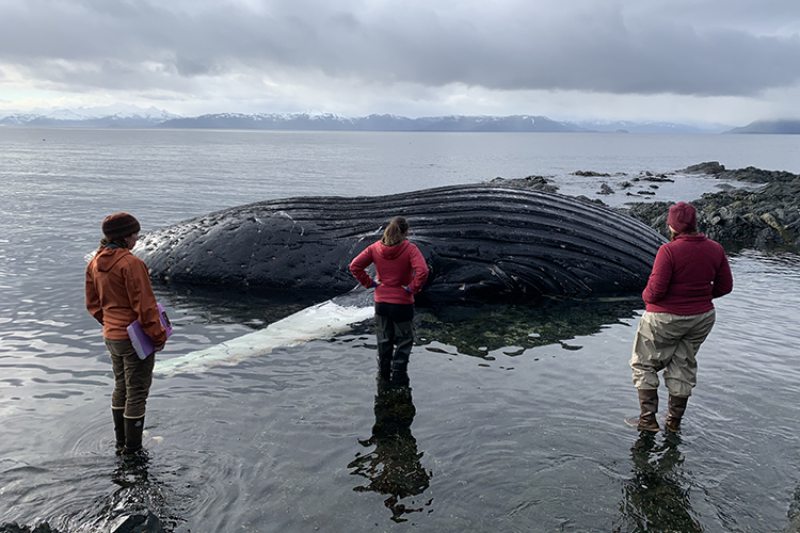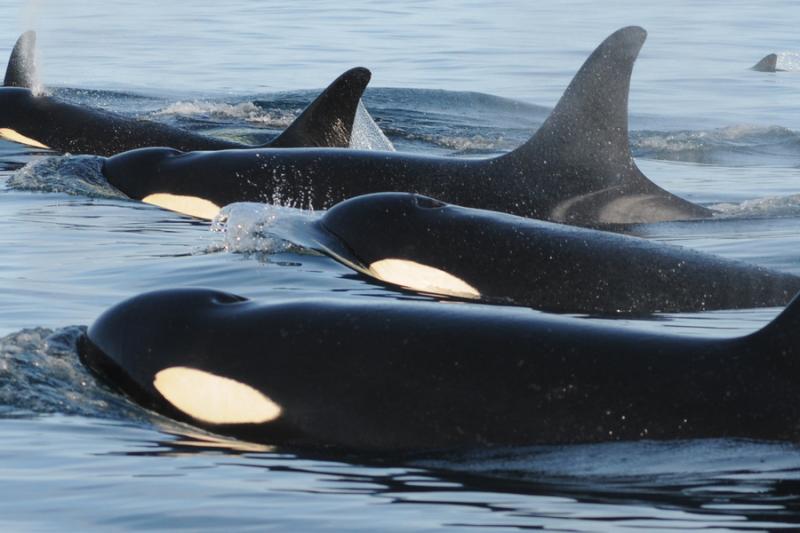Whale on the Beach
On February 10, 2022, ferry crew from the Alaska Marine Highway System reported a dead whale on a beach on Killisnoo Island in Southeast Alaska. AMHS and the United States Coast Guard provided photos to NOAA of a recently expired humpback whale.
NOAA Fisheries staff traveled to Killisnoo Island, near Angoon, via floatplane on February 14 to collect data and samples from the
carcass.
Thanks to biologists at Glacier Bay National Park and Preserve, the whale was identified as SEAK #235, a female who was first documented in 1977. She was given the nickname “Spot” by the Jurasz family because of her unique tail markings.
Getting to these remote islands is never easy—it takes coordination and dedication by all parties. The team of six was lucky to have good weather to access the carcass. They were also willing to forgo any previous Valentine’s Day plans to collect samples to investigate the cause of death.
“I’m not going to say who, but I heard at least a couple of folks say ‘Best Valentine’s Day ever,’” said Mandy Keogh, Alaska Marine Mammal Stranding Response coordinator, about the all-women response team. However, they were fighting against the tides and limited daylight to collect valuable data.
“Due to the high tide in the middle of the day, our time with the whale was limited,” said Mandy. “But this was our weather window and we wanted to get there as soon as possible. As it turned out, we learned so much from examining this carcass.”
Four Decades of Sightings
Humpback whales can be identified by unique markings on the underside of their tail flukes. Researchers take photos of the flukes as whales raise them out of the water when they dive. The photos document and track individuals over time, but it wasn’t always known that fluke markings could be used to identify individual humpbacks. The Juneau, Alaska-based Jurasz family, through their organization Sea Search Ltd, were pioneers in the development of this now-foundational research tool. They were likely the first researchers anywhere to notice distinct flukes and to use the tail markings to document individual humpback whales. It's due to the early work of Sea Search Ltd. that we know as much as we do about Spot’s story.
“It is so sad to hear that this whale has died, and at the same time amazing to think that she has been swimming around, feeding, and mothering calves for all this time,” Virginia (Jurasz) Palmer said after hearing the news about Spot.
More than 200 Spot sightings have been logged in the Southeast Alaska Humpback Whale Catalog database maintained by Glacier Bay National Park and the University of Alaska Southeast (UAS) in Sitka. She also has 22 sightings on Happywhale.com, a global research collaboration and community science web platform containing data for encounters of more than 66,000 humpback whales.
Since she was first seen in 1977, Spot has had an impressive 46-year sighting history. She was documented every year from 1986 through 2014 in or near Glacier Bay, making her one of the park’s most regular whale visitors. The last record of her in Glacier Bay was in May 2020 by Sean and Janet Neilson when they saw her with her 12th known calf.
The most recent sighting of Spot was in Sitka Sound in March 2021 by community scientist Dennis Rogers who submitted a fluke photo to Happywhale.
Humpback whales are long-lived, migratory mammals. They feed in Southeast Alaska during spring, summer, and fall and breed in warmer tropical waters during winter. However, humpback whale migration is staggered. Some whales stay late into the year and others return early—humpback whales can be seen in Alaska’s waters every month of the year. Research by UAS professor Jan Straley and others shows that some whales may even forgo the migration altogether and stay in Alaska feeding all winter. Still, there are relatively few humpback whales around this time of year, and February strandings are not as common as they are in other seasons. It’s unknown if Spot migrated this past winter and was back early, or if she never left Alaska.
While finding a dead whale can be a sad experience, the insights gained by studying the carcass helps scientists understand more about the whale’s life. They can learn why the whale died and what physical or environmental factors contributed to the death. In this case, the necropsy team found scars on Spot’s tail and healing wounds along her left side. These indicated she had been recently entangled in marine debris or fishing gear. The photos Dennis Rogers posted to Happywhale in March 2021 show that Spot did not have these scars then. It is unclear how the entanglement may have affected Spot’s survival, but entanglements are known stressors. They cause injury and reduce health by wasting energy expenditure and impeding swimming and feeding. Apps like Happywhale highlight the importance of community scientists and the data and photos they share as we try to learn more about humpback whales.
The necropsy team collected numerous body condition measurements. They examined the carcass for bruising or other injuries and collected skin, blubber, muscle, baleen, and other samples. The results of the necropsy and analysis of the collected samples haven’t been finalized yet. However, the information the team has gained from photo identification comparisons already tells an intriguing story about an amazing animal.
Good Coordination Among Responders
“Every response is different, but they all require good communication and coordination within NOAA and by our partners as well,” said Mandy Keogh after the necropsy was completed. “Our team was very appreciative for the communications from AMHS and the U.S. Coast Guard and for the break in weather that allowed us to respond to this whale.”
“This total team effort highlights the cooperation and commitment between Southeast Alaska communities and its service organizations. Air Station Sitka is proud to not only serve the communities of Southeast Alaska, but to have a great rapport with the other service organizations throughout the region,” said U.S. Coast Guard Air Station Sitka Commanding Officer Captain Brian McLaughlin. “While this is an unfortunate event, we are proud to play our part in helping find answers for the long-term health of the marine mammal ecosystem.”
This stranding response and the knowledge of the history of this whale was dependent on coordination and communication from people at many organizations, including:
- Alaska Marine Highway System
- U.S. Coast Guard
- NOAA Fisheries
- Glacier Bay National Park and Preserve
- University of Alaska Southeast in Sitka
- Happywhale
- Jurasz family/Sea Search Ltd
For the stranding team, it was a Valentine’s Day to remember.
If you are curious to learn more, the University of Alaska Southeast has an impressive 4D Virtual Whale Necropsy portal where you can experience a virtual necropsy without the smell!
If you see an entangled whale in Alaska, you can help by keeping your distance and reporting the sighting (pdf, 3 pages) NOAA Fisheries at (877) 925-7773. If you find a dead whale or other marine mammal, do not touch it or remove any parts. All injuries or deaths should be reported as soon as possible to the 24-hour NOAA Alaska Marine Mammal Stranding Network at (877) 925-7773. All marine mammals, live or dead, are protected under the Marine Mammal Protection Act.







